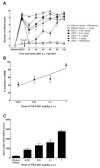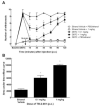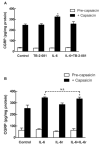Reversal of pancreatitis-induced pain by an orally available, small molecule interleukin-6 receptor antagonist
- PMID: 20599324
- PMCID: PMC3313485
- DOI: 10.1016/j.pain.2010.05.022
Reversal of pancreatitis-induced pain by an orally available, small molecule interleukin-6 receptor antagonist
Abstract
Pancreatic pain resulting from chronic inflammation of the pancreas is often intractable and clinically difficult to manage with available analgesics reflecting the need for more effective therapies. The mechanisms underlying pancreatitis pain are not well understood. Here, the possibility that interleukin-6 (IL-6) may promote pancreatitis pain was investigated with TB-2-081 (3-O-formyl-20R,21-epoxyresibufogenin, EBRF), a small molecule IL-6 receptor antagonist that was semi-synthetically derived from natural sources. The potential activity and mechanism of TB-2-081 were investigated following the induction of persistent pancreatitis using dibutyltin dichloride (DBTC) in rats. TB-2-081 displaces the binding of IL-6 to the human recombinant soluble IL-6 receptor with apparent high affinity and inhibits IL-6 mediated cell growth. Systemic or oral, but not intrathecal, administration of TB-2-081 reversed DBTC-induced abdominal hypersensitivity in a dose- and time-dependent manner. IL-6 levels were significantly up-regulated in the dorsal root ganglia (DRG) of rats with pancreatitis on day 6 after DBTC injection. IL-6-enhanced capsaicin-evoked release of calcitonin gene-related peptide from cultured DRG neurons was blocked by TB-2-081. Our data demonstrate that TB-2-081 acts as a systemically available and orally active small molecule IL-6 receptor antagonist. TB-2-081 effectively reduces pancreatitis-induced pain through peripheral mechanisms that are likely due to (a) increased expression of IL-6 in the DRG and (b) IL-6-mediated sensitization of nociceptive neurons. The activity of TB-2-081 implicates an important role for IL-6 in sustaining pancreatitis pain. Strategies targeting IL-6 actions through small molecule antagonists may offer novel approaches to improve the therapy of chronic pancreatitis and other chronic pain states.
Copyright © 2010 International Association for the Study of Pain. Published by Elsevier B.V. All rights reserved.
Figures





Comment in
-
A new utensil in our toolbox: exploring the role of IL-6 in pain using a naturally occurring antagonist.Pain. 2010 Nov;151(2):235-236. doi: 10.1016/j.pain.2010.06.033. Epub 2010 Jul 17. Pain. 2010. PMID: 20638791 No abstract available.
Similar articles
-
Endothelin A receptor in nociceptors is essential for persistent mechanical pain in a chronic pancreatitis of mouse model.World J Gastroenterol. 2025 Jun 21;31(23):103848. doi: 10.3748/wjg.v31.i23.103848. World J Gastroenterol. 2025. PMID: 40575333 Free PMC article.
-
Gene expression profiling and endothelin in acute experimental pancreatitis.World J Gastroenterol. 2012 Aug 28;18(32):4257-69. doi: 10.3748/wjg.v18.i32.4257. World J Gastroenterol. 2012. PMID: 22969188 Free PMC article.
-
Attenuation of persistent experimental pancreatitis pain by a bradykinin b2 receptor antagonist.Pancreas. 2010 Nov;39(8):1220-5. doi: 10.1097/MPA.0b013e3181df1c90. Pancreas. 2010. PMID: 20531238 Free PMC article.
-
Nociception in persistent pancreatitis in rats: effects of morphine and neuropeptide alterations.Anesthesiology. 2003 Feb;98(2):474-84. doi: 10.1097/00000542-200302000-00029. Anesthesiology. 2003. PMID: 12552208 Free PMC article.
-
Role of neurogenic inflammation in pancreatitis and pancreatic pain.Neurosignals. 2005;14(4):158-65. doi: 10.1159/000087654. Neurosignals. 2005. PMID: 16215298 Free PMC article. Review.
Cited by
-
The Toll-like receptor 4 antagonist TAK-242 protects against chronic pancreatitis in rats.Mol Med Rep. 2017 Oct;16(4):3863-3868. doi: 10.3892/mmr.2017.7105. Epub 2017 Jul 27. Mol Med Rep. 2017. PMID: 28765897 Free PMC article.
-
Recent advances in the understanding and management of chronic pancreatitis pain.J Pancreatol. 2024 Mar;7(1):35-44. doi: 10.1097/JP9.0000000000000163. Epub 2023 Dec 12. J Pancreatol. 2024. PMID: 38524856 Free PMC article. Review.
-
Current understanding of the neuropathophysiology of pain in chronic pancreatitis.World J Gastrointest Pathophysiol. 2015 Nov 15;6(4):193-202. doi: 10.4291/wjgp.v6.i4.193. World J Gastrointest Pathophysiol. 2015. PMID: 26600977 Free PMC article. Review.
-
IL-6- and NGF-induced rapid control of protein synthesis and nociceptive plasticity via convergent signaling to the eIF4F complex.J Neurosci. 2010 Nov 10;30(45):15113-23. doi: 10.1523/JNEUROSCI.3947-10.2010. J Neurosci. 2010. PMID: 21068317 Free PMC article.
-
Configurational reassignment and improved preparation of the competitive IL-6 receptor antagonist 20R,21R-epoxyresibufogenin-3-formate.J Nat Prod. 2012 Apr 27;75(4):661-8. doi: 10.1021/np2008957. Epub 2012 Feb 23. J Nat Prod. 2012. PMID: 22360661 Free PMC article.
References
-
- Arruda JL, Colburn RW, Rickman AJ, Rutkowski MD, DeLeo JA. Increase of interleukin-6 mRNA in the spinal cord following peripheral nerve injury in the rat: potential role of IL-6 in neuropathic pain. Brain Res Mol Brain Res. 1998;62:228–235. - PubMed
-
- Arruda JL, Sweitzer S, Rutkowski MD, DeLeo JA. Intrathecal anti-IL-6 antibody and IgG attenuates peripheral nerve injury-induced mechanical allodynia in the rat: possible immune modulation in neuropathic pain. Brain Res. 2000;879:216–225. - PubMed
-
- Ballantyne JC, LaForge KS. Opioid dependence and addiction during opioid treatment of chronic pain. Pain. 2007;129:235–255. - PubMed
-
- Caterina MJ, Schumacher MA, Tominaga M, Rosen TA, Levine JD, Julius D. The capsaicin receptor: a heat-activated ion channel in the pain pathway. Nature. 1997;389:816–824. - PubMed
-
- Chaudhry MA, Bowen BD, Eaves CJ, Piret JM. Empirical models of the proliferative response of cytokine-dependent hematopoietic cell lines. Biotechnol Bioeng. 2004;88:348–358. - PubMed
Publication types
MeSH terms
Substances
Grants and funding
LinkOut - more resources
Full Text Sources
Other Literature Sources
Medical
Research Materials

